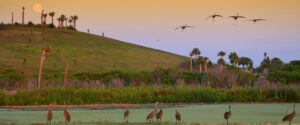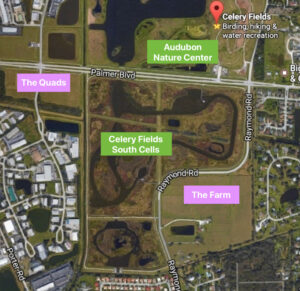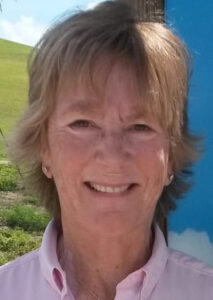A national company seeks to build 171 homes near the popular natural preserve.
By Our Changing Environment
Original Air Date: Nov. 17, 2023
WSLR News: The Sarasota Audubon Society is a driving force behind the Celery Fields wetlands preserve. So it doesn’t come as a surprise that the group is now mobilizing resistance against a high-density housing project a national homebuilding company wants to build next to the birdwatcher and kite flyer haven. Julie Morris and Jono Miller, hosts of the Our Changing Environment show on WSLR, interviewed Sarasota Audubon President Jeanne Dubi this week.

Celery Fields
There are strong ties between the Sarasota Audubon Society and the Celery Fields. The environmental group has become a steward for the natural preserve, with an educational center on site since 2015. Audubon has facilitated talks between the heirs of the adjacent Raymond Road Farm and a green land trust, to put their 49 acres in conservation. But the offer DR Horton put on the table was apparently irresistible. Long story short: The homebuilding company is now asking the Sarasota County Planning Commission to rezone the land from agricultural use to housing, to build 171 homes.

Map of the Celery Fields
And that is not good news for the area’s water management, because the farmland is part of the larger wetland system. Celery Fields as a floodwater management area became necessary when the county decided to turn nearby land next to an Interstate Highway exit into a major employment center. Celery Fields has since become a haven for wildlife, particularly birds, and an ecotourism destination. Today, it is essential to manage flooding in the area, as Jono Miller points out.
Jono Miller: Whatever the current design of the stormwater facility at the Celery Fields, there is a bigger storm out there coming. And we know from Hurricane Ian that we’re seeing increased rainfall amounts, that storms are lingering and dumping more water.
WSLR News: Also, more construction surrounding Celery Fields is creating more impervious surfaces, which increases the need for the stormwater facility. And the farmland could be used for added capacity, preventing flooding of neighborhoods in the next 100-year storm.
For Jeanne Dubi, the best outcome would be to use the Raymond Road Farm land for stormwater management.

Jeanne Dubi
Jeanne Dubi: The ideal situation would be for the county to take it over and use it for stormwater and revegetate it. We could help, the Conservation Foundation could help in organizing some funds for that. There’s plenty of grant money out there. So it’s not beyond the bounds of possibilities. The county could do it. And if you look at the map of the Celery Fields, .. the Raymond Road farm property sort of nestles right into it. It’s a no-brainer to understand that that belongs in the Celery Field system. So, the 100 acres that the county restored is really the heart of the Celery Fields, because the plantings took into account what birds needed and what other animals needed. It’s become .. the real focal point … And lo and behold, Raymond Road is in the heart of the heart of it.
WSLR News: This is not the first time Audubon became part of a grassroots movement to help Celery Fields. When Sarasota County wanted to sell the “Quad” land it owned adjacent to Celery Fields for commercial development a few years ago, environmentalists mobilized and won.
JD: Yeah, well the Quads, they were on the county surplus land list, destined for sale … They were already owned by the county. … So yes, there was a grassroots movement … It was not our grassroots movement, but we .. certainly had our position, and we joined forces in the end. And the only solution we felt we could come up with, …was to say to the county, ‘We will manage that land. If you do not sell it, … Sarasota Audubon will manage it. And in conjunction with the Conservation Foundation, we’ll raise the money to do that’. And that’s where we are right now. So we’ve been working with the county for the last couple of years to figure out the design of it. We’ve been raising money, and we have to raise $4 million.
WSLR News: So what can people do to help with the Raymond Road farmland?
JD: It’s going to be a diminished experience. There’s no question about it. And so we need everybody’s help to let the county commissioners know that this is not a good idea. And so you can just click on the website and it can show you .. the way you can send your comments to the county commissioners. It’s at the Planning Commission right now under review. And then, after they make a recommendation to the Board of County Commissioners, there’s a public hearing where we can voice our concerns. And at that meeting, the county commissioners can vote yay or nay for that particular.
Julie Morris: Is there also a public hearing before the Planning Commission?
JD: We hope that they will have a public hearing.
WSLR News: Despite the fact that the Celery Fields has become a major natural attraction, it is not a county park. But that’s the next chapter.
To listen to the full interview with Jeanne Dubi, go to wslr.org, click on “Archive” and look for the Our Changing Environment show on Tuesday, Nov. 14. WSLR News thanks hosts Julie Morris and Jono Miller for sharing the content of their show.
WSLR News aims to keep the local community informed with our 1/2 hour local news show, quarterly newspaper and social media feeds. The local news broadcast airs on Wednesdays and Fridays at 6pm.